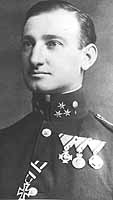| Otto Jindra | |
|---|---|
 | |
| Born | March 18, 1896 |
| Died | May 2, 1932 (aged 36) |
| Place of birth | Chlum u Třeboně, Bohemia |
| Place of death | Czechoslovakia |
| Allegiance |
|
| Service/branch | Aviation |
| Rank | Hauptmann |
| Commands held | Flik 1, Flek 11, Fliegergruppe G |
| Awards |
|
Hauptmann Otto Jindra was an Austro-Hungarian flying ace during World War I, credited with nine aerial victories while flying as an aerial observer. He doubled in excellence as a leader and administrator. After World War I and Austria-Hungary both ended, Jindra became a major mover in founding a Czechoslovakian air arm, which he eventually rose to command.[1]
Pre-aviation service[]
Jindra graduated from the Artillery Academy in Vienna in 1905, and went into the 14th Mountain Artillery Regiment. He was promoted to Oberleutnant in December 1912. With the outbreak of war, Jindra served as battery commander and regimental adjutant as his regiment swung into combat at the Battle of Lemberg on the Eastern Front. He won the Bronze Military Merit Medal in this action.[2]
Aviation service[]
Jindra applied for a transfer to aviation. When it came through, he was directly assigned to Flik 1 as an observer on 10 September 1914.[3] Jindra soon became a master at controlling artillery fire from the observer's seat, using a radio transmitter installed by Benno Fiala von Fernbrugg.[4] However, on 14 November 1914, Jindra and his pilot were brought down by the riddling fire of a Russian cavalry unit. They counted 180 bullet holes in their crashlanded plane, pulled their personal gear from the wreckage, and headed home, leaving a torched wreck behind them.[5]
In late January 1915, Flik 1's commanding officer was taken prisoner. Despite being a non-pilot, Jindra was selected to replace him.[6]
On 13 June 1915, Jindra was flying as an observer for Max Libano in an Albatros B.I when the pair were attacked by two Russian Morane-Saulnier monoplanes. Despite being armed with only a pistol and a carbine, the Austro-Hungarians managed to down both attackers. On 27 August, Jindra scored again.[7] On 1 September, he was raised to Hauptmann. Later in the year, he began to learn piloting right there in his squadron. By 11 December, he was qualified as a Feldpilot, receiving his badge on the 20th.[8]
On 5 January 1916, Jindra fought his first dogfight as a pilot. He made a forced landing when slightly wounded, with a punctured gas tank. It was not until 29 March that he would score his first win as a pilot.[9] On 9 April 1916, he became an ace.[10] Three days later, he would participate in an air raid that would rattle the Russians; Jindra took Godwin Brumowski as his gunner, and they attacked a military parade being reviewed by Czar Nicholas II. They scattered the parade with seven small bombs and shot down two of the four intercepting Russian planes.[11]
Jindra would score twice more in 1916,but flying a Hansa-Brandenburg C.I. On 29 September, Jindra and his gunner would hit an attacking Russian pilot in the throat, and the Russian would die immediately after crash-landing. On 18 December, Jindra would swoop on a Russian observation balloon and Jindra's observer would kill the observer and destroy the balloon.[12][13]
In January 1918, Jindra was reassigned to command Flek 11. However, he was soon reassigned again, to command a bomber group Fliegergruppe G. Before he could settle into this command, he was severely injured in a night flying accident, which ended his participation in the war.[14]
Post World War I[]
After the dissolution of the Austro-Hungarian Empire, Jindra became Czechoslovakian citizen. He was instrumental in raising a Czechoslovak Air Force.[15] He eventually rose to become its Chief of Staff.[16]
Awards and decorations[]
- Order of the Iron Crown
- Military Merit Cross (twice)
- Military Merit Medals in bronze and silver
- Iron Cross of 1914, 2nd class
Sources of information[]
- ↑ Austro-Hungarian Aces of World War 1. pp. 86, 89.
- ↑ Austro-Hungarian Aces of World War 1. p. 86.
- ↑ http://www.theaerodrome.com/aces/austrhun/jindra.php Retrieved on 4 April 2010.
- ↑ Austro-Hungarian Aces of World War 1. p. 86.
- ↑ Austro-Hungarian Aces of World War 1. pp. 86–87.
- ↑ Austro-Hungarian Aces of World War 1. p. 87.
- ↑ http://www.theaerodrome.com/aces/austrhun/jindra.php Retrieved on 5 April 2010.
- ↑ Austro-Hungarian Aces of World War 1. p. 87.
- ↑ Austro-Hungarian Aces of World War 1. p. 87.
- ↑ http://www.theaerodrome.com/aces/austrhun/jindra.php Retrieved on 5 April 2010.
- ↑ Austro-Hungarian Aces of World War 1. p. 87.
- ↑ http://www.theaerodrome.com/aces/austrhun/jindra.php Retrieved on 5 April 2010.
- ↑ Austro-Hungarian Aces of World War 1. p. 87.
- ↑ Austro-Hungarian Aces of World War 1. p. 87.
- ↑ Austro-Hungarian Aces of World War 1. p. 87.
- ↑ http://www.theaerodrome.com/aces/austrhun/jindra.php Retrieved on 5 April 2010.
References[]
Austro-Hungarian aces of World War 1 Christopher Chant. Osprey Publishing, 2002. ISBN 1-84176-376-4, ISBN 978-1-84176-376-7.
The original article can be found at Otto Jindra and the edit history here.